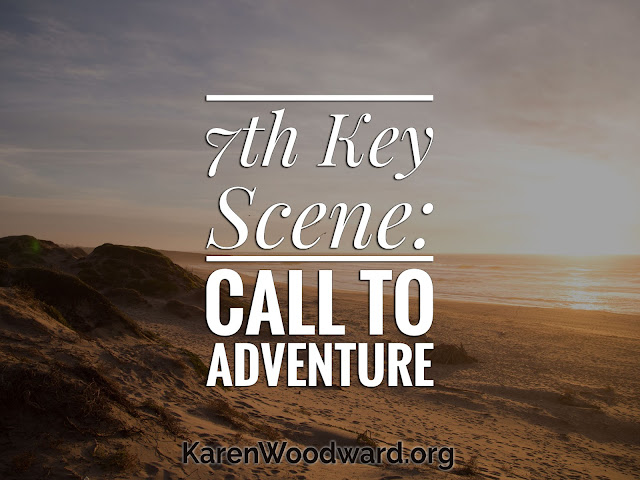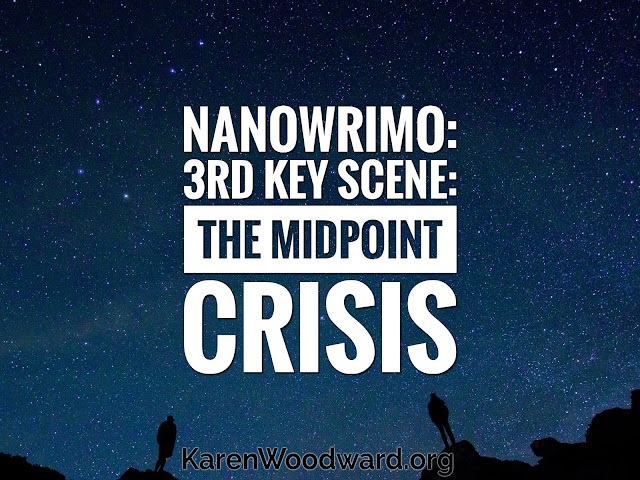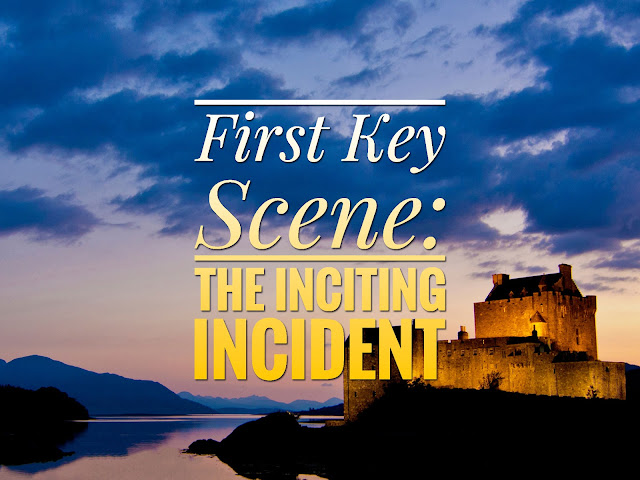“I have been successful probably because I have always realized that I knew nothing about writing and have merely tried to tell an interesting story entertainingly.”
The Midpoint: Breaking It Down
In the Call to Adventure the protagonist accepts a quest, takes on a challenge that will occupy her till the Climax at the end of the story. I’m going to call this challenge the Story Goal because it will be the engine driving the action of the story, of the plot, right up to the very end. This goal defines the protagonist’s arc and becomes the story’s backbone, tying all the other character arcs to itself.
The protagonist doesn’t always accept the Call to Adventure. Often she rejects the Call and must be talked into it, often by a mentor. If a mentor is involved they may give the protagonist something that will aid her on her journey. For example, in Star Wars IV: A New Hope, Obi-Wan Kenobi gives Luke his father’s lightsaber.
What is it?
A problem/challenge. At the Call to Adventure the hero is offered a challenge or adventure. The Call must make it clear what the hero’s goal is.
Stakes established. The Call to Adventure should reveal the states. We need to know what will count as a win and what will count as a loss, and we need to know how the protagonist will be rewarded for a win and what price will be exacted if she loses.
Call is freely accepted. The protagonist must be able to reject the Call to Adventure. Sure, there might be dire consequences if she rejects the Call but, nevertheless, it’s important that she has the opportunity.
The upshot: During the Call to Adventure, a decision must be made, action then taken and a conflict faced.
The Difference Between the Inciting Incident and the Call to Adventure
As we saw when we talked about the Inciting Incident, the Ordinary World is relatively static at the beginning of the story. Often, there is something deeply wrong with the protagonist’s normal existence, but it could also be that she is simply in stasis. She is surviving but she isn’t living.
Another way of looking at the protagonist’s initial state is that she has reached a kind of false, local, optima. The protagonist isn't happy and knows she's not happy but is scared that if she tries to change, her life will get worse.
For example, in the movie The Matrix, at the beginning of the story Neo—or, rather, Mr. Thomas Anderson—knows that something is wrong; not just with his life but with the world. He doesn’t know what exactly is wrong, but he has searched for the answer all his life.
The _Inciting Incident_ shatters the protagonist’s status quo, her state of equilibrium. Something happens that changes the protagonist’s world, a change which will, sooner or later, shatter her status quo. The Inciting Incident creates an imbalance, an inequality that the protagonist must, eventually, address.
At the beginning of _The Matrix_ words, unbidden, flash on Anderson's computer screen: "Follow the white rabbit." I would argue that this is the inciting incident, the event that sets a series of other events in motion that, eventually, leads to his call to adventure. Or the Inciting Incident could have happened in the backstory when Cypher first began to work for the first Matrix.
One could argue that Anderson receives a few calls to adventure, but I think that the Call came when Morpheus tries to talk Neo out of his office building so he can avoid the Agents capturing him. Mr. Anderson declines the Call to Adventure. This changes when, at the end of Act One when, Neo is offered the choice between the red pill and the blue pill. Then he makes a choice and is locked into the quest.
I find it fruitful to view the Inciting Incident and the Call to Adventure as conceptually distinct because they serve different, though complementary, functions.
As we saw in that section, the Inciting Incident (which is an exciting incident) is meant to a) grab the audience's attention and b) sets the story in motion by breaking the status quo. The Call to Adventure, on the other hand, connects the hero to the cataclysmic changes in the Ordinary World.
You can see how these two events, the Inciting Incident and Call to Adventure, would often go together.
The bottom line: If how you view the Inciting Incident and Call to Adventure works for you, then great! In the end there's only one rule: use what works for you.
Where is it?
The Call to Adventure happens at the same time or shortly after the Inciting Incident. Definitely within the first act (the first 25% of the story).
How is it connected to the protagonist’s desires?
The Call to Adventure connects the protagonist to the changes in the world that the Inciting Incident introduced. The Call to Adventure must also be a call to take some action that will move the protagonist closer to fulfilling their internal and external desires.
The Midpoint: Examples
In Star Wars IV: A New Hope, the Call to Adventure occurs when Obi-Wan Kenobi asks Luke to join him as he travels to Alderaan to bring the plans for the Death Star to the resistance.
Testing the Scene Example
Was a challenge put forward? Yes! Obi-Wan Kenobi asked Luke to join him on a dangerous mission to aid the rebel alliance.
Are the stakes clear? Yes. If the information Princess Leia gave to R2-D2 isn’t delivered to the resistance then the rebellion will be defeated.
Is the quest freely accepted? Yes. Luke rejects the Call at first, but after his aunt and uncle are murdered by the Empire Luke takes up the quest and accompanies Obi-Wan Kenobi.
How the Call to Action is Implemented in Three Genres: Action, Romance & Mystery
Action Genre
I’ve gone over this, above.
Romance Genre
I said before, when we were going over the inciting Incident, that that point is where the lovers-to-be are thrown into conflict. The Inciting Incident is the point at which the protagonist’s world is altered, but it’s not necessarily where the Call to Adventure is given.
In a romance story the Call to Adventure has to do with the call to bond with another human being, the call to make oneself vulnerable. It is the call to love another even as we wish to be loved.
By the way, in doing research for this article I came across a terrific resource: The Hero’s Journey for Romance Writers.
Murder Mystery Genre
In a murder mystery, the Call occurs when the sleuth agrees to take on the responsibility of solving the murder and, by so doing, to bring justice to the community.
Every post I pick a book or audiobook I love and recommend it to my readers. This serves two purposes. I want to share what I’ve loved with you, and, if you click the link and buy anything over at Amazon within the next 24 hours, Amazon puts a few cents in my tip jar at no cost to you. So, if you click the link, thank you! If not, that’s okay too. I’m thrilled and honored you’ve visited my blog and read my post. :-)
Today I’d like to recommend Dialogue: The Art of Verbal Action for Page, Stage, and Screen by by Robert Mckee. From the blurb: “From Macbeth to Breaking Bad, McKee deconstructs key scenes to illustrate the strategies and techniques of dialogue. DIALOGUE applies a framework of incisive thinking to instruct the prospective writer on how to craft artful, impactful speech.”
That’s it! If you’re doing NaNo, how’s it going? My take on NaNo is that as long as you write more in November than you would have otherwise, you’re a winner!
Talk to you again tomorrow, in the meantime, good writing!
Word count so far: 11,385
Word count for today: 1370
Total words this month: 12,755










